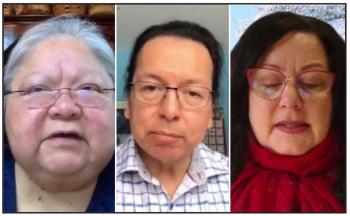Image Caption
Summary
Local Journalism Initiative Reporter
Windspeaker.com
Three people in the field of education and community-based language revitalization pushed the requirement for more and better funding for the preservation and regeneration of Indigenous languages. They spoke on the second day of a five-day virtual symposium on Indigenous languages hosted by Canadian Heritage.
“We’re still stuck on words of the day, but what we’re striving for is actually to have our stories told and our knowledge told in a complete package,” said Alan Corbiere, assistant professor in the history department at York University.
Corbiere, Anishinaabe from M’Chigeeng First Nation, likened the work that needs to be done to a braid of sweetgrass: three strands that must be woven together.
The first strand is preserving language by recording it and creating a database. The second strand is maintaining the language through both speaking and writing it. The third strand is revitalizing the language, which will only be realized when new words are created and new stories composed. Each strand is as important as the other, but right now, he said, there is nothing holding them together.
Métis educator Sharon Parenteau, general manager with the Louis Riel Institute in Winnipeg, agreed.
“Right now we’re doing a Michif word of the day on our website. It’s a great start, but we just need so much more than that,” she said.
“We need to ensure that the richness of vocabulary and meaning is not lost and there is a record of our language in its entirety where learners can hear the words in context and how they’re spoken in daily life.”
Parenteau said that although the Métis are considered one of three Indigenous peoples in Canada, they do not receive one-third of the funding.
“In fact, we only receive a fraction of it. We know that Michif is more critically endangered than Cree, Ojibwe or Inuit languages, and we need to set up a system that works because we’re running out of time. The approach can’t be pan-Aboriginal. We need to focus on a distinctions-based,” said Parenteau.
A generous estimate has 1,000 fluent Michif speakers left.
Dedicated funding is needed in a variety of areas, said Dr. Lorna Wanosts'a7 Williams, professor emerita of Indigenous Education, Curriculum and Instruction at the University of Victoria and Canada Research.
Funding has to support Indigenous language teachers to develop their languages, both on the land and in the community, as well as allowing them easy access to resources at universities.
“Because (Indigenous language programming is) a new development, it’s a whole new area of study, and in most universities, there aren’t any spaces for Indigenous knowledge, Indigenous languages and those need to be created. So there needs to be additional funding for that,” said Williams.
Parenteau also pointed out that support had to come from “Eurocentric institutions.”
Without divulging the name of the institution, she said she and her team met with the dean of education to ask him to “stop pushing out education students.” Parenteau said she told him Indigenous cohorts were necessary, teaming fluent language speakers with students. She said they were told that the changes would not be made because education students were the institution’s “cash cow.”
“That’s really disheartening,” said Parenteau.
“Funding is always going to be an issue,” said Corbiere.
“When we talk about Indigenous languages we know that the work needs to continue in a much more robust way,” said Gary Anandasangaree, parliamentary secretary to the Minister of Crown-Indigenous Relations. “The Indigenous Languages Act and what’s going to come as the result of the act, I think, is going to be instrumental in making the required changes that we need to make to support the revitalization of the languages.”
Anandasangaree represented the federal government at Tuesday’s symposium, which he said was an important step in implementing the act.
“Success in this endeavour is essential if we are to make real and lasting progress toward addressing the unacceptable gaps in education, health, social and economic outcomes that exist for so many First Nations, Inuit and Métis in Canada,” Anandasangaree said. “Language and culture are inseparable. Language is the repository that allows knowledge, customs and traditions that define people to themselves to be passed from generation to generation. The links from language to identity, to self-esteem, to social well-being are irrefutable.”
Local Journalism Initiative Reporters are supported by a financial contribution made by the Government of Canada.

